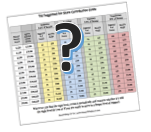Is the Suggested Fair Share Contribution Guide Too Complex? Too Demanding? Too Rigid?
Nope, Nope, and Nope!
by Bill Clontz, Stewardship Consultant
This is the time of year wherein many congregations are conducting annual stewardship drives. That means we receive a lot of inquiries about now concerning the UUA’s Suggested Fair Share Contribution Guide (SFSCG).
You may find it useful to look at the guide as you read this blog- there are links here on our website (https://stewardshipforus.com/stewardship-resources/suggested-fair-share-contribution-guide/) or on the UUA website (http://www.uua.org/finance/fundraising/budget).
We find this guide to be most helpful for congregations in fostering healthy discussions about stewardship. Congregations that actively use the guide have a better stewardship environment, including better results in their campaigns.
But not everyone loves the SFSCG, so let’s look at the concerns some have expressed and see if we can address them.
The SFSCG in Review
It’s too complex: OK, I will be the first to admit that at first glance, this does look like something the IRS must have invented this form. But take a moment to look at the form and the accompanying information about how to use it, you will see that it’s easy.
The only “work” involved is determining what your adjusted gross income (AGI) is. That is basically what you make, minus all the deductions and exclusions allowed on our taxes. For most of us, that number near the bottom of the first page on your IRS 1040 form when you last filed taxes.
Some people prefer just to use their take home pay (usually a monthly number), which is fine if you prefer, but you might find the number you use to calculate your gift is a lower number if you use the AGI number.
Once you have the number you will use, and apply the additional deductions suggested on the Guide, just find the range on the left side of the form that represents your income.
Now, move to the right until you reach the number that seems as high as you are ready to take as your commitment. You now have a suggested gift to consider.
Now, how hard was that?
It’s too demanding: I very much feel the opposite is true. In fact, this is one of the strongest positives about the Guide – it truly is a social justice tool.
You will notice across the form that there are suggested gift ranges from 2% of AGI up to 10%. This recognizes that we all have different capacities at different levels of income and obligations.
It’s too rigid: I hear this occasionally, and frankly, it mystifies me that someone may think this.
— First, it’s a Suggested Fair Share Contribution Guide, not a Mandatory Guide.
— Second, it makes allowances for exceptional expenses in making our decisions.
— Third, this is but one tool we may use in making our decisions. Congregations often provide members several sources to consider, such as a quartile analysis of congregational giving (see our blog, at https://stewardshipforus.com/?s=Quartile+analysis), a Gift Ladder (showing distributions of commitments), and size of mean, median, and costs per pledge unit numbers, for example.
What About Simpler Approaches?
Two approaches we see with some frequency are a reduced or simplified table or one formula for all.
The problem with a “simplified” table is that it tends to generate categories of income or gifts that are too broad to be useful . It’s not a simpler table – it’s just one with fewer choices.
The one formula for all, such as “Let’s all pledge 5%,” has an undeniable appeal, and at least in my view, having such a number as an underlying goal (we hope everyone will pledge at least 5%, and those of us who can, will do more) is good.
But simply saying 5% for everyone is problematic. For some people, 5% is simply not doable at this point in their lives. Someone in that position should not feel they are less of a member because they cannot meet such a goal.
Those of us who can give more should not feel that when we have reached 5%, we have done all we need to do. I want to encourage that person to do more, commensurate with their capacity and dedication. That is essential , if for no other reason than to help cover any shortfalls resulting from those who cannot give 5%.
The Guide neutralizes both problems.
Use the SFSCG and to do so actively
What does “actively” mean?
— Periodically explain how to use the Guide. This takes just a few minutes. Consider a short video on your web site or to show on a loop in your Commons.
— Ensure that some testimonials include reference to the Guide, and how it helped to inform their decisions.
— Have copies of the Guide in your Stewardship Station, a place where members can always pick up the Guide, case statements, stock transfer and pledge forms, automatic deduction forms, etc.
— Remind all that this is a cornerstone for stewardship decision making, but it is only one of several to consider. Let them know that your team is ready to help or discuss at any time. Finally, acknowledge that we are each responsible for our decisions supporting our congregation and our movement.
Bill Clont z is a stewardship consultant with the Stewardship for Us Team, supporting the UUA. Reach Bill at bill@stewardshipforus.com, via UUA Congregational Life, (http://www.uua.org/finance/fundraising), or via your regional staff.
z is a stewardship consultant with the Stewardship for Us Team, supporting the UUA. Reach Bill at bill@stewardshipforus.com, via UUA Congregational Life, (http://www.uua.org/finance/fundraising), or via your regional staff.
This blog has a new posting no less than once a month. You may find it and more at www.stewardshipforus.com. You are welcome to sign up for stewardship updates at the blog.
Comments and discussion are always welcome; share your experiences and ideas with us.

Stewardship Consultant Barry Finkelstein has been a Unitarian Universalist congregational stewardship consultant since the Fall of 2007 and has worked with over 100 congregations on annual budget drives, capital campaigns, and strategic planning. This is Barry’s last post as he is retiring effective January 1, 2025.

In my congregation, we reproduce the chart for the Suggested Fair Share Contribution Guide both in the pledge drive brochure and on the back of the pledge card.
I have also simplified the text/instructions (in quotation marks below) that go next to the chart because space in those publications is tight and because many people avoid considering this if the math or instructions appear hard.
It needs to be a soft sell — the idea is just to get folks to be willing to consider the chart . To think about how it might apply to them, and if not this year, then maybe next year. Or maybe they will find meaning in setting a multi-year goal for themselves to “get on the chart.” It’s more about psychology and values than math.
“Giving is a function of commitment and resources. When thinking about your income and your financial commitment to our congregation, please consider your UU values. What makes this UUA chart fair and useful is the ability to include meaningful or unusual exceptions (in income or expenses) in your personal economic life.
Wherever you find the right level for you, re-visit it periodically and re-assess whether it’s still the right level or whether you are ready to move to a deeper level of support using the instructions below.
1. Calculate your own monthly income or resource level.
2. ADD any unusual or periodic income such as inheritance, business or investment income, etc.
3. SUBTRACT any extraordinary expenses such as large medical expenses, care of a parent, or large financial expense, etc.
4. From the Adjusted Monthly Income column, move to the right to find a giving level that you are ready to support.”
Thank you Christy. Your comments and approach sound spot on from so many perspectives, and your simplified instructions, in my view, do the job without degrading the usability of the Guide.
For other readers, Christy has also shared with us an excellent stewardship drive brochure her team worked up for this year, one that reflects the philosophy she expressed in her comments here. Well done! Here is a link to it: https://stewardshipforus.com/wp-content/uploads/2017/03/Pledge-drive-brochure-2017-18-final.pdf” alt=”Stewardship Drive Brochure” />